
Quick Slant: MNF - Empires Forged From Cold and Hunger
Mat Irby’s Quick Slant
Twenty-one is an age where the pragmatist inside you is in full-on fisticuffs with the dreamer. People like Curly Lambeau—square jaw, plump lips, full hair, handsome—like a member of One Direction seduced some time ago by the call of the barbell and the protein shake—don’t assimilate easily to staring down the long corridor of a life in drab brick buildings, moving cans of meat in crates along concrete floors.
The smell of it, the routine—long, dim hallways with tiny windows that let in four months of sun before gray skies return for another eight. The furnace barely keeps your toes warm in boots with no holes; the paychecks go to the baby before they can fund a new pair.
When you’re twenty-one, there’s still hope—founded or not—that this is not your fate. This can’t be the rest of my life, you pray. When you’re a kid like Curly Lambeau, you always feel meant for more. It’s just a matter of time, you think, until my real plan saves me from this for-now one.
You walk outside at day’s end along macadam streets, staring out at the Door Peninsula across the bay. Your back feels full of ground glass, your soles bruised, the cracks in your blackened fingers stinging in the cold wind. You’re called to rest, to pay the bill for what your body’s endured, but you know too well—that’s how the cycle ensnares you. That’s how this becomes your life.
So instead, you take that fleeting thought—a daydream that flashes as you pass the high school field where you lived out your glory days between goal lines and sidelines—and you flesh it out. You think of ways to make it real. It compels you to one solution: start my own damn team. Then one question beyond that: how do I fund it?
Lambeau couldn’t shake it. He asked his boss at the Indian meatpacking plant for money—$500, equivalent to $10,000 today—for uniforms and a name. He partnered with a newspaperman to schedule games. On September 14, 1919, the Packers made their debut with a 53–0 victory, funded by donations from spectators. Two years later, they joined the NFL.
Flash forward to Philadelphia in 1933—right at the teeth of the Great Depression. Burt Bell was no factory hand; he was a Penn man—son of a prevost, born to ballrooms and grand pianos. But by ‘33, Philadelphia was swollen with hunger; you could count the chimneys that still burned on one hand. And a ball coach for Penn and Temple throughout the 20s, Bell’s well had run dry.
The defunct Frankford Yellow Jackets had shuttered in 1931 but still held territorial rights to Philadelphia and maintained a relationship with the NFL. Bell learned the rights and a place in the schedule were for sale at a modest price, even then.
For Bell, this wasn’t about being caught between a dream and reality; it was a now-or-never haymaker to leave the bread lines behind. He levied his house and sold his wife’s jewelry, pushing everything he had into the center of the table to buy the Yellow Jackets’ old seat at the table. He named the team the Eagles and made himself general manager. On October 15, 1933, they played the Giants in their first game.
The NFL today is a printing press for billions, but in its modest early years, it was a white-knuckle ride. Both teams, at times, barely kept the lights on; over the years, they’ve been two of the NFL’s most crucial franchises. Lambeau coached the Packers to six championships, turning the team over to Vince Lombardi, who added five more. Bell’s Eagles won twice under Greasy Neale, two more in recent memory, were instrumental in aiding integration, and Bell served as NFL commissioner in the 40s and 50s, ushering the league into modernity with innovations like the NFL draft.
Today, the Packers and Eagles are tentpoles. Each is a unique character on the NFL roster—indispensable and stubborn as the cities that birthed them. And when they meet, they aren’t just battling for this January, but to defend all the Januaries that came before, and those yet to come. To defend risks taken by Curly and Burt—to guard their history: Bednarik, White, Carmichael, and Dawkins; Lombardi, Starr, Favre, and Nitschke. To hold this all as sacred as they stand in each moment along the way, building history onto history—empires forged from cold and hunger.
Eagles
Implied Team Total: 22
The Eagles got off to a slow start a year ago, later culminating in a red-hot streak that eventually bought rings of diamonds and gold.
They didn’t start slowly in 2025, but they had a rough middle, first snatching defeat from the jaws of victory against Denver, then being humiliated by the Giants on TNF in back-to-back weeks. Seemingly back on track, the Eagles appear to be rounding into form, and as they do, it’s tough to shake the memory of what they did last time around.
In an evenly matched game this week, they enter as slight underdogs at +1.5, which is tied to home-field advantage. If the Eagles were at home, they would be favored.
According to Pythagorean expected wins, based on points for and points against, Philadelphia is only on pace for 9.5 wins; however, they are second in wins over expected.
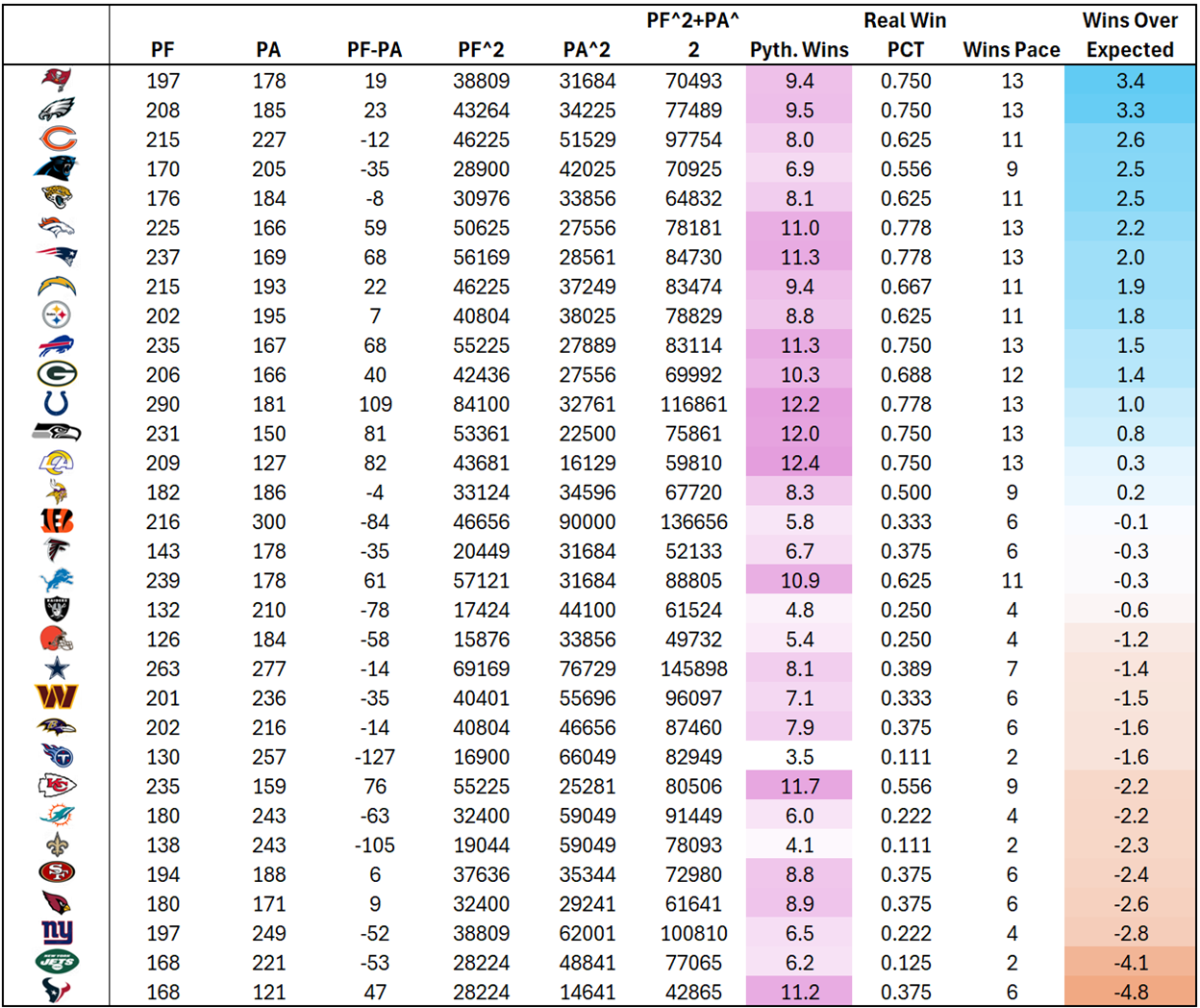
The Eagles are above average in both offensive and defensive EPA per play.
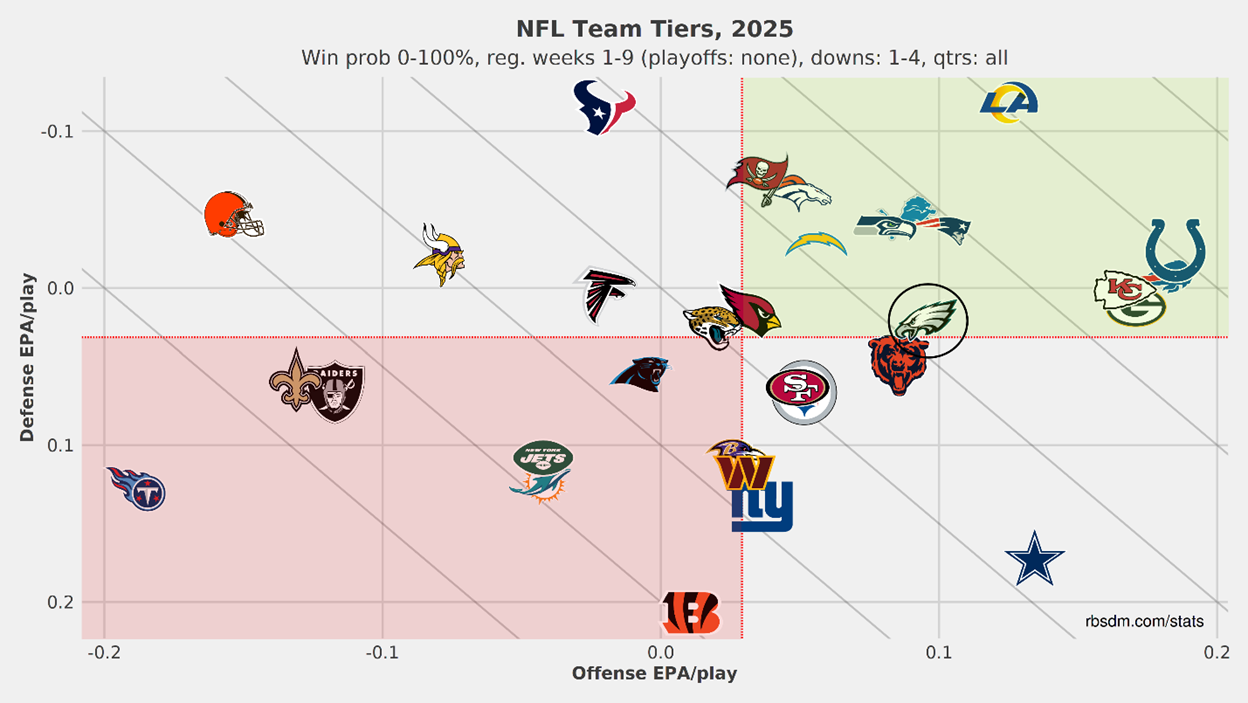
They rank eighth in offensive EPA per play and 15th in offensive success rate. They rank 12th in EPA per play on dropbacks and 20th in offensive success rate on dropbacks.
The Eagles maintain a very low play volume at 59 offensive plays per 60 minutes (T-28th). They are slow to snap the football (28.8 seconds to snap, 30th). They run the ball on 47% of their offensive plays (T-3rd). The Eagles have only trailed by seven or more points for seven total plays—15% of their offensive snaps (6th). Their run rate drops to 42% (T-2nd) when they are down by this much, but only the Seahawks have a higher rate in these situations.
After owning the lowest pass rate over expected (PROE) last season (-8.8%), the Eagles are far more centrist this time—still, technically run-heavy, but not nearly as much as they were under OC Kellen Moore, who is now in New Orleans.
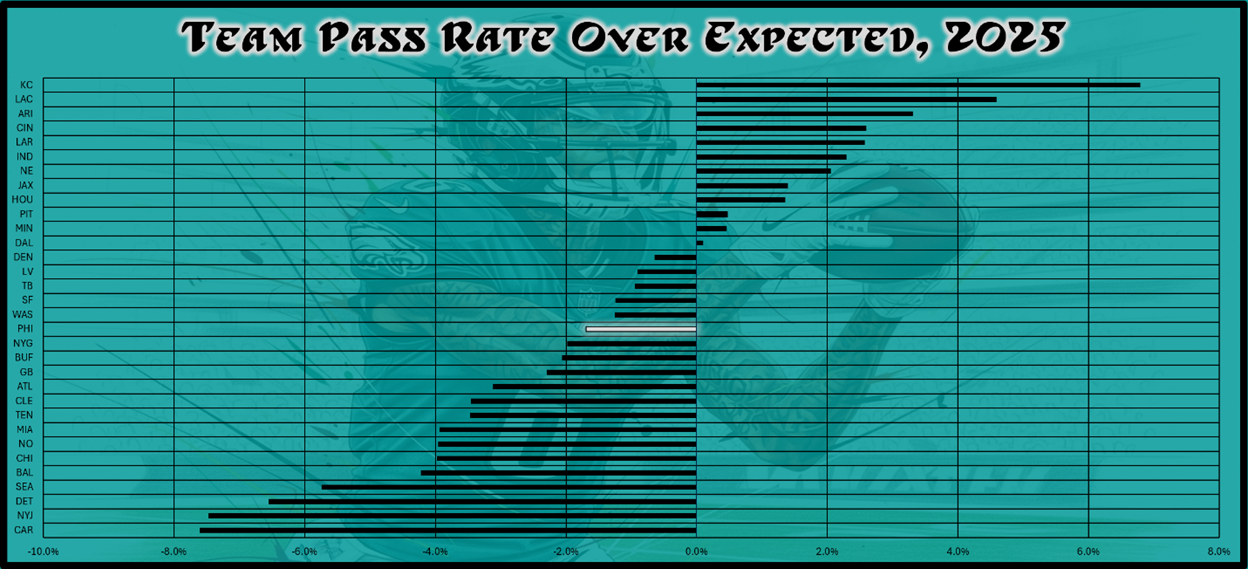
Generally speaking, these factors would combine to make the Eagles a suboptimal fantasy environment, but they also run everything through a hyper-concentrated group of players. The answer to which Philadelphia players are fantasy relevant is almost binary: an Eagles player either is or isn't a fantasy option with no gray area. They have five fantasy starters: QB Jalen Hurts, RB Saquon Barkley, TE Dallas Goedert, and WRs A.J. Brown and Devonta Smith. There is never a time to consider anyone else.
Regardless of how slow they pace and how low their play volume is, if they sustain drives and score points, and they run everything through these five players, all five can have some level of fantasy viability.
QB Jalen Hurts has dropped back 33.3 times per game (27th), and he has attempted 26.9 passes per game (31st). His rate of attempts to dropbacks is just 80.8%, which is tied for 35th among QBs with at least 20 dropbacks per game. This might seem alarming at first, but this is okay. This low rate indicates that the player is more prone to scrambling or taking sacks than most; in the same range, we see names like Josh Allen (82.9%), Kyler Murray (82.6%), Jaxson Dart (81.8%), Lamar Jackson (80.8%), Drake Maye (77.7%), and Jayden Daniels (76.7%).
Hurts has 22 scrambles (T-6th), leading to 159 rushing yards and two scores, but of course, Hurts is always buoyed by an inordinate number of one-yard runs, many of which lead to scores. This season, he has been a little off the pace, scoring only five rushing TDs total (T-3rd), but he still has an elite rushing platform, which raises his floor and ceiling.
Within the lowered context of his passing volume, Hurts has good per-attempt stats. He ranks 10th in YPA (7.8), fifth in QB rating (114.4), and fifth in off-target throw percentage (12.6%). He is above average in EPA and CPOE.
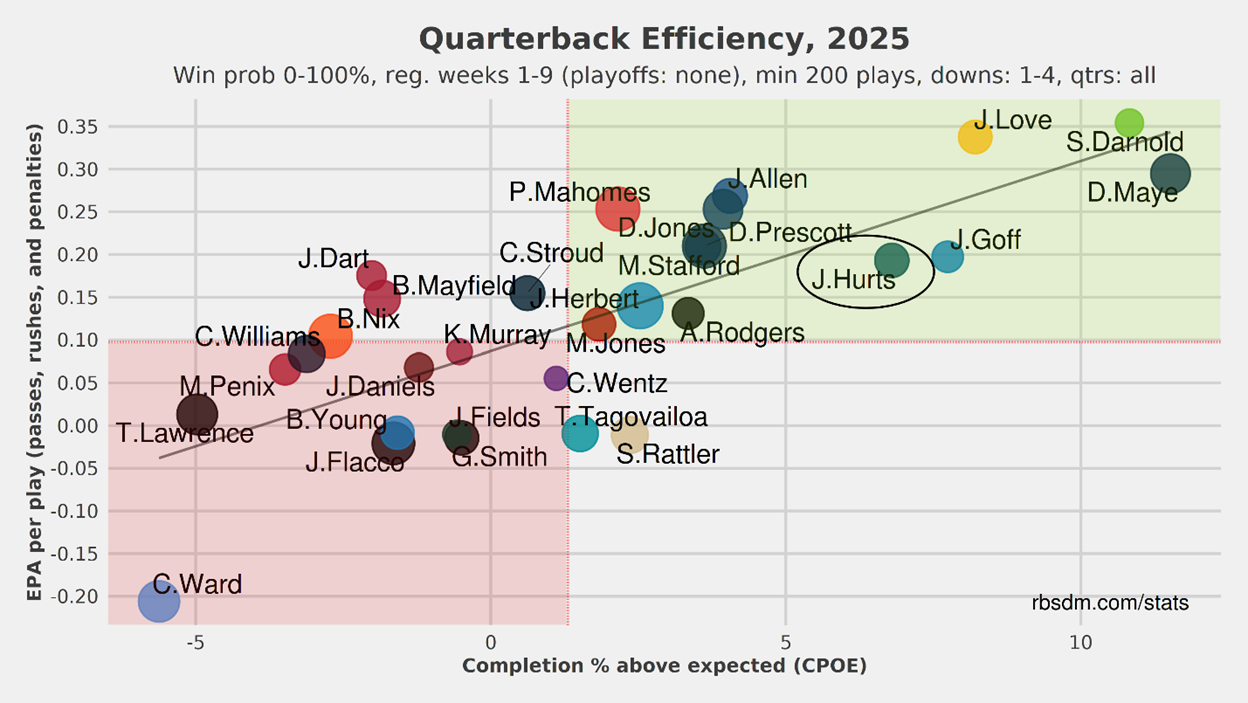
Most importantly, he ranks third in fantasy points per dropback (0.67). The play style waters down his total fantasy production, but within that context, he is still terrific.
Green Bay ranks 15th in defensive EPA per play allowed and 13th in defensive success rate. They are 14th in defensive EPA per dropback allowed and eighth in defensive success rate on dropbacks. Their success rate in the passing game is their defensive strength.
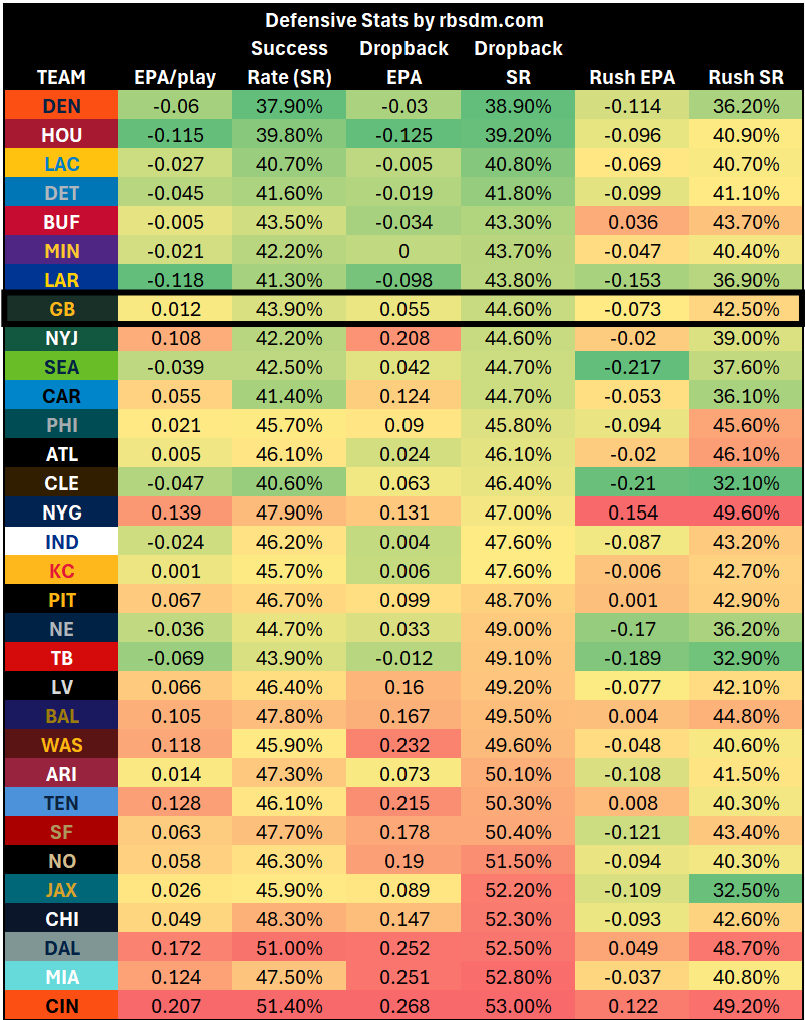
The Packers’ defense has surrendered the 14th most fantasy points to opposing QBs in their last five games. Opposing QBs rank 30th in rushing yards against Green Bay during that span, but the Packers haven’t faced any overly mobile QBs throughout that time.
Since their 40-40 tie with Dallas in Week 4, the Packers have only gotten better against QBs from game to game. However, the players they have faced have been subpar. Facing Hurts, the Packers will be tested in a way they haven’t in a while.

As I alluded to, the Eagles have a narrow target dispersion. They have three pass catchers who draw at least a 20% target share: Brown (26.3%), Smith (27.5%), and Goedert (21.0%). Only one other player—Barkley—draws even a 10% share, and no one else draws even 5%. Smith and Brown rank 10th and 11th among WRs, in target share, respectively; Goedert ranks fourth among TEs.

Fortunately, these players have these outstanding target shares; unfortunately, in such a low-volume offense, they need them even to be relevant for fantasy. Brown has been the disappointment so far, ranking 33rd in PPR/G. Smith has operated more recently as the Eagles’ WR1, and he ranks 15th in PPR/G. Meanwhile, Goedert ranks fifth among TEs.
Brown and Smith haven’t been consistent fantasy earners. Brown has had two blow-up spots and four weeks where he was outside of the top 24. He missed the Eagles' last game just before the bye, but should be back this week.
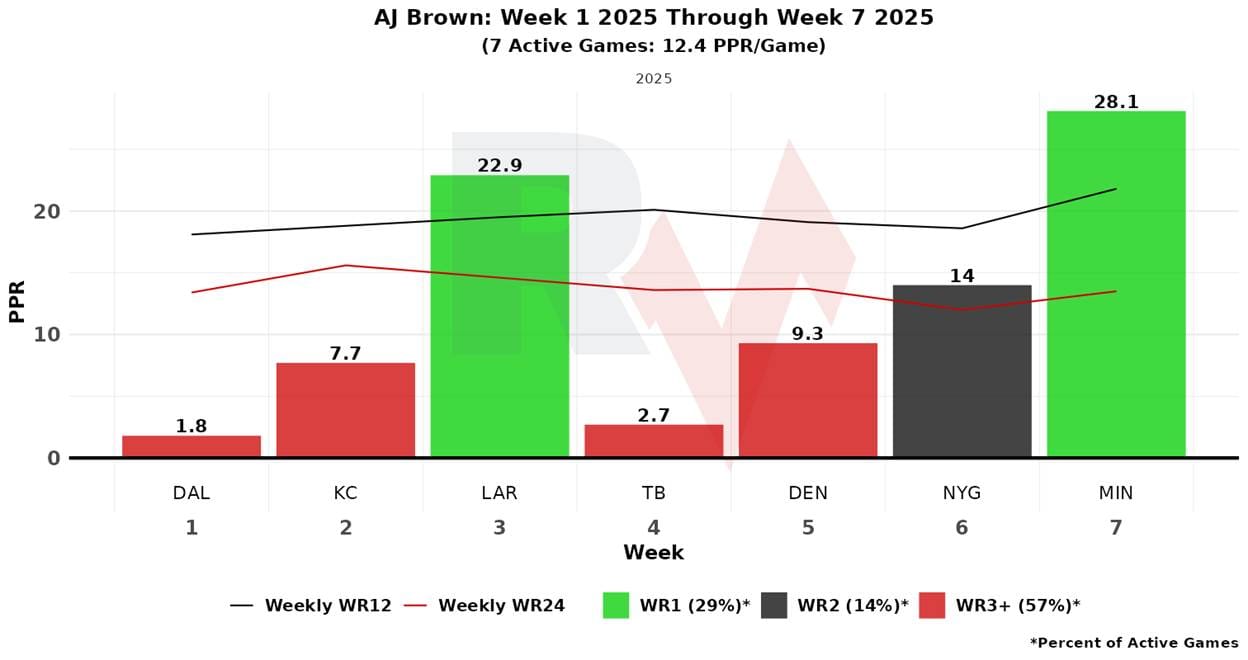
Smith has been a WR1 three times—twice, by the skin of his teeth, and outside of the top 24 four times.

Goedert, on the other hand, has not only recorded four top 12 weeks, but two others have been tolerable, and he’s only had one week where he bottomed out. His consistency comes with a massive caveat.

Goedert’s superpower this year has been unusually high TD production. Goedert leads the NFL with seven TDs, but his TD rate of 17.9% is almost certainly unsustainable.
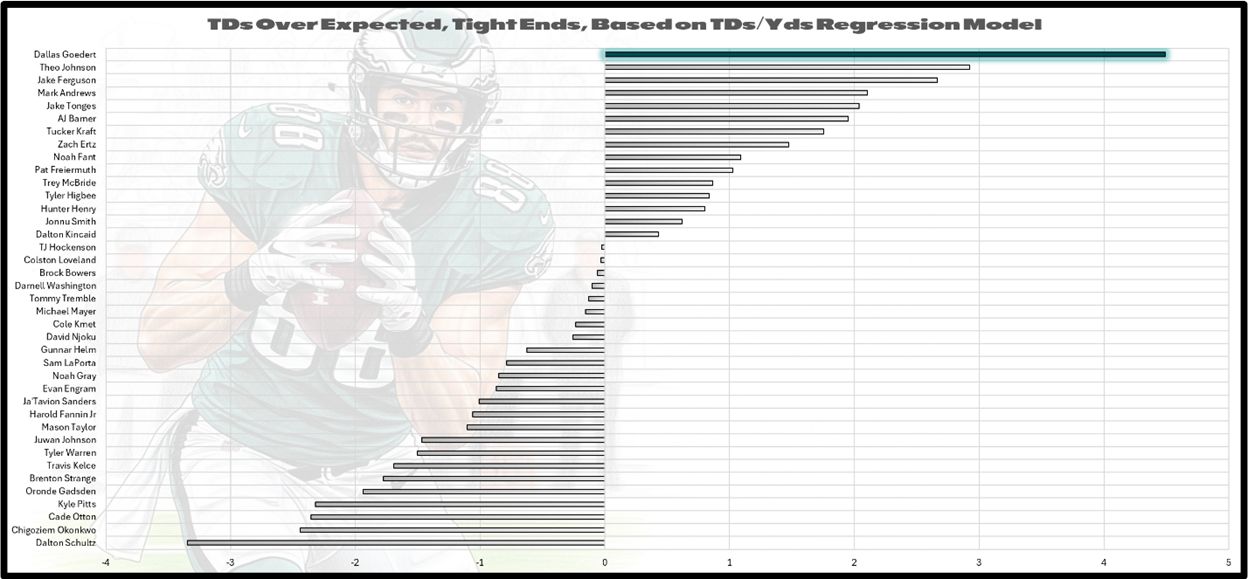
This is by far the highest TD rate of Goedert’s career. Among TEs with at least 40 targets, only three since 2000 have had a TD rate higher throughout an entire season: Bubba Franks in 2001 (18.4%), Robert Tonyan in 2020 (18.6%), and Julius Thomas in 2014 (19.4%). Goedert’s career TD rate is 6.2%.

The Packers run 76.5% zone (11th) and have a fairly even split between single-high (51.5%) and shell coverage (48.5%). They use Cover 3 most at a rate of 32.9%. They don’t use any other coverage at a rate of 20% or higher. They barely blitz at all (17.4%, 29th).
Fantasy Points’ coverage matchup tool assigns a zero-based matchup grade to each pass-catcher based on their opponent’s use of specific types and rates of coverage and how that pass-catcher performs against them. Positive numbers indicate a favorable matchup and negative numbers indicate an unfavorable one.
The types and rates of coverage the Packers use are expected to mostly bother the Eagles’ pass-catchers, with Goedert (-12.9%) and Brown (-13.3%) facing negative coverage grades and Smith (+8.4%) facing a slightly positive one.
PFF’s matchup tool is player-based, pitting the PFF ratings of individual players against each other for an expected number of plays based on historical tendencies and rating on a scale from great to poor.
In this model, Smith also has an advantageous matchup. PFF grades his assignment as good, along with Hurts. Goedert’s matchup grades out as great, but Brown’s grades out as fair.
Based strictly on raw statistics, the Packers have allowed the 14th most fantasy points to opposing TEs—so, neutral. If we look closer, we see a higher expected points (EP) and a lower fantasy points over expected (FPOE), which indicates that the Packers have been subjected to volume from opposing TEs, but have held their ground on a per-route basis. Further investigation bears this out, as opposing TEs rank seventh in targets and third in receptions, but 27th in receiving yards and 32nd in YPR. The only two TEs to hit on efficiency during this sample are Jake Ferguson and Trey McBride, the TE4 and TE1 in PPR/G.
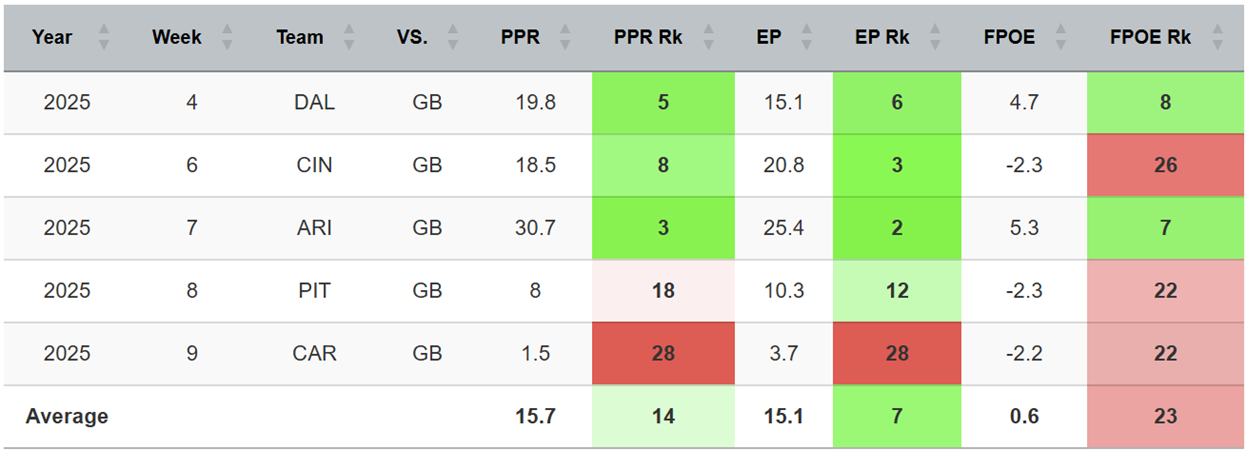
Opposing WRs have had more success, ranking sixth against Green Bay in their last five games. Against WRs, the Packers have surrendered volume and efficiency, surrendering the eighth-most receptions and sixth-most receiving yards during that span.
One significant reason the Eagles didn’t seem like themselves early in the season was the unexpected failures of their stalwart offensive line. Between injuries and underperformance, it felt like the walls were inexplicably cracking on PFF’s preseason no. 1 unit, but the ship has begun to right itself of late, and a bye in Week 9 will only help further restore health.
Still bearing the scars of their slow start, the Eagles' pressure rate over expected (PrROE) allowed is +12.12% (23rd of 28 teams this week). Meanwhile, the Packers’ defense is at +8.8% PrROE generated (13th of 28 teams this week). The composite between them provides the Eagles with one of the most significant disadvantages of the week in pass-blocking.
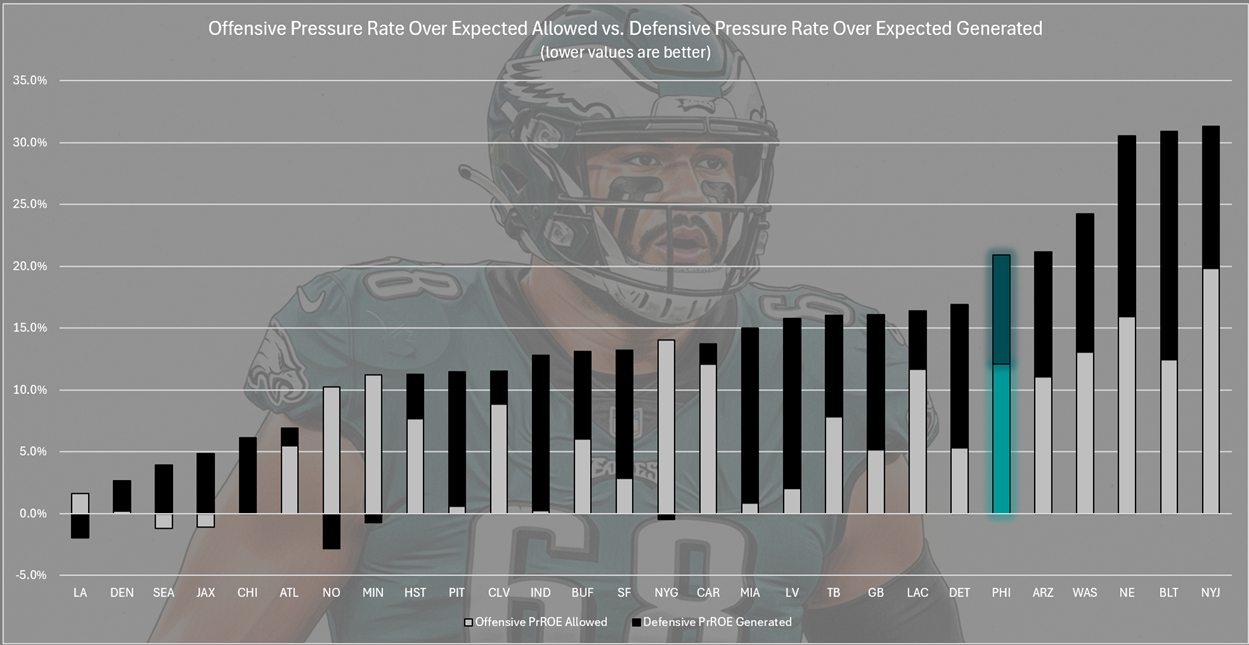
However, the Eagles’ PFF pass-blocking grades through their first four games averaged 64.15; through their last four, they averaged 72.86. LT Jordan Mailata, LG Landon Dickerson, and RT Lane Johnson, three of the best in the NFL at their position, are finally healthy and firing on all cylinders (they are still without their starting C Cam Jeurgens). What appears to be a significant disadvantage for the Eagles based on their performance earlier this season may not be anymore.
The apologetics are less necessary to defend the run blocking of the Eagles, who generate 2.06 adjusted yards before contact per attempt (Adj YBC/Att, 13th of 28 teams this week) and face off against a Packers’ squad that has allowed 2.31 Adj YBC/Att T-22nd of 28 teams this week). This composite offers the Eagles one of the bigger run-blocking advantages in Week 10.

A year after being undeniably dominant, RB Saquon Barkley has struggled to regain his form. Some of this can be laid at the feet of the health and dysfunction of the offensive line earlier this season, but some could be reserved for Barkley himself. However, Week 8 represented a significant turning point.
The Eagles’ last game against the Giants served as a rising tide that lifted all boats; Barkley’s stats all look better this week than they did two weeks ago.

Suppose we believe in the thesis that the Eagles’ offensive line is returning to full health. In that case, Week 8’s Giants’ game should serve as proof positive, and a reminder that any RB—even Barkley—can’t do it all by himself (as we know from many, many years of Barkley toiling in New York). And if we believe that is so, and their last game’s improvement is connected, we should also think the best is yet to come.
Barkley has actually been reasonably efficient. The Eagles have ranked fourth in offensive rush EPA and 12th in offensive success rate on rushes. He has a +71 rush yards over expected (RYOE, 12th).
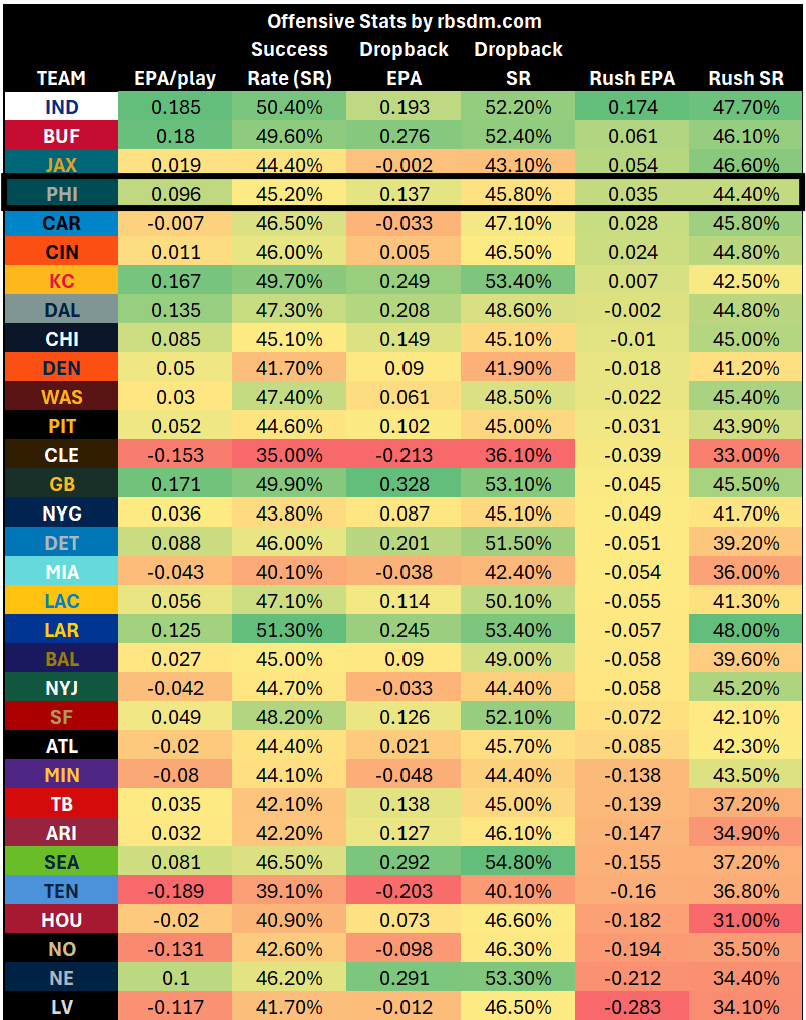
The Packers have been beatable in the run game. They rank 17th in defensive EPA per rush allowed and 20th in defensive success rate on rushes. The only RBs to have run a significant amount in their last five games have put up excellent fantasy outputs.

If we expect Barkley to run a fair amount—and we probably should—he’s pretty primed for a nice day.
